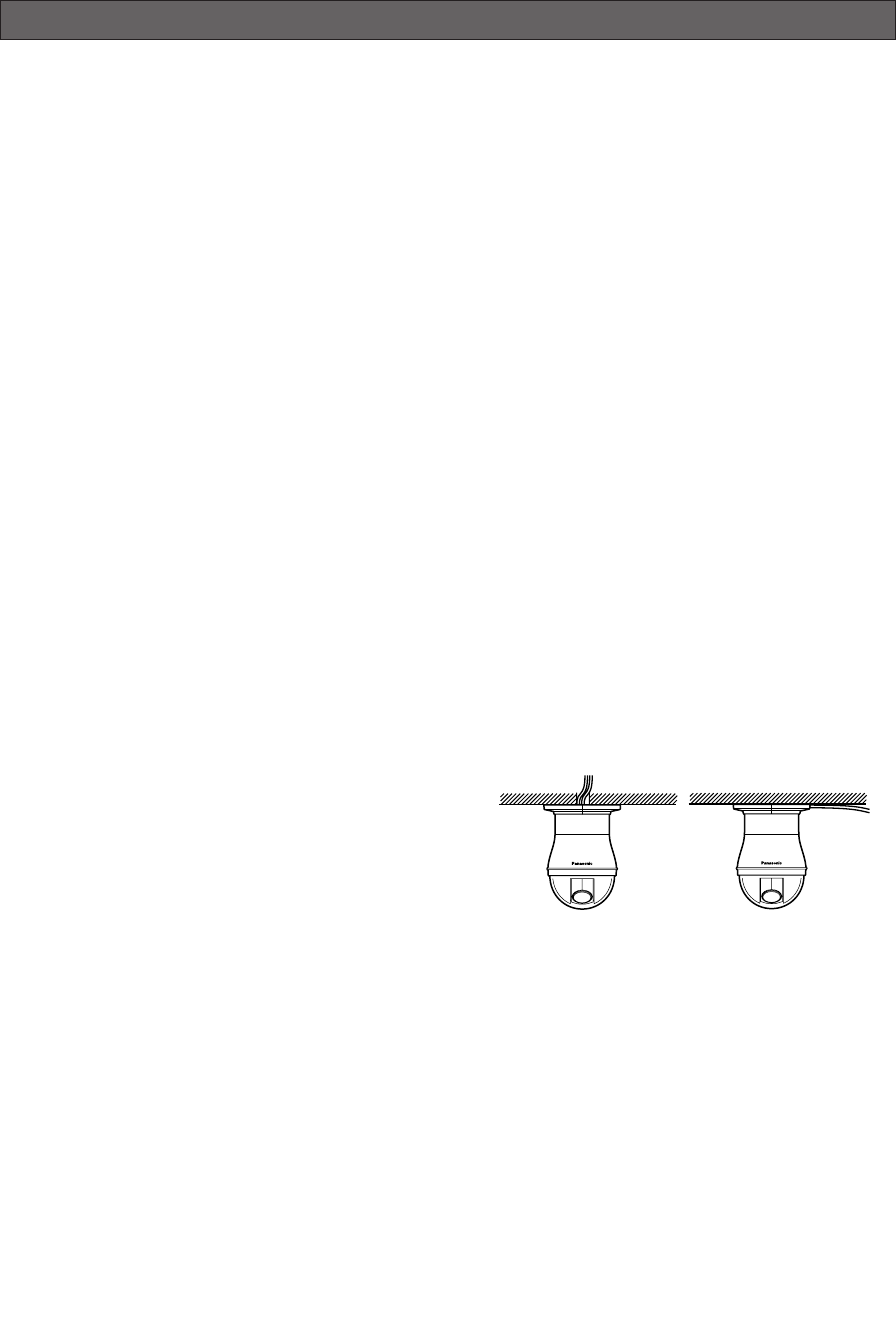
INSTALLATION PRECAUTIONS
Warning: Discuss the installation location for the
camera with your retailer, and select a place that is
strong enough for the installation. If you install the
camera on a ceiling or wall, except for accidents
caused by fault in the camera, Panasonic holds
absolutely no responsibility for accidents caused by
the camera falling due to unsuitable installation.
Take sufficient care when installing the camera. If
the installation is not strong enough, be sure to
sufficiently reinforce the location and check that it is
safe.
Warning: Always request installation work from a
qualified service person or system installer. Lack of
technical knowledge creates the risk of fire, electric
shock, personal injury, and material damage.
■ Camera Installation Location
• Install the camera on a ceiling (concrete, etc.) at a
location that is sufficiently strong to support it.
• When installing the camera on a ceiling of
insufficient strength (like a drop ceiling), use the
optionally available WV-Q105 Direct Attachment
Ceiling Mounting Bracket or the WV-Q116
Embedded Ceiling Mount Bracket.
• For ceiling mounting, use the optionally available
WV-Q117 Ceiling Mount Bracket.
• For wall mounting, use the optionally available WV-
Q118 Wall Mount Bracket.
■ This camera is an indoor camera. It is not
designed for outdoor use.
■ This camera is designed for use in a hanging con-
figuration only. Using it in an upright or inclined
configuration can cause malfunction and shorten
the life of the camera.
■ Install the camera in a horizontal configuration,
with the dome pointed downwards.
■ Never install or use the camera in the following
locations.
• Areas directly exposed to rain and water
• Near a swimming pool or other areas where
chemicals are used
• Food preparation areas and other locations where
there are large amounts of steam vapor and oil, in
flammable atmospheres, other special environments
• Areas where radiation, X-rays, strong electric
waves, or magnetism is generated
• At sea, in coastal areas, or in areas where corrosive
gas is being generated
• Areas outside of the allowable ambient operating
temperature range (-10 °C to +50 °C {14 °F to 122
°F})
• In a motor vehicle, on a boat, or other areas subject
to strong vibration (This camera is not designed for
use in a vehicle.)
• Near an air conditioner outlet, near a door that opens
up to the outdoors, or any other area subjected to
temperature extremes (Such conditions can cause
clouding and condensation formation on the dome
cover.)
■ Wiring the Camera
• If you need to connect a ground, be sure to do it before
you connect the main power plug. Also, when
removing the ground, be sure to disconnect the main
power plug.
• The camera does not have a power switch, so it turns on
as soon as the power cord is plugged into a power outlet.
During the electrical work, configure the power supply to
the camera so it can be turned on and off. A self-cleaning
function is activated (PAN/TILT/ZOOM/FOCUS) when the
camera is turned on.
■ When wiring the camera, its cables (power, video
output, RS485, alarm in, alarm out) can exit out
the side or the top of the camera.
• When using the top cable exit configuration, drill a
hole in the ceiling to allow passage of the cables.
(See step 3 on page 15.)
• When using the side cable exit configuration,
prepare the cutout in the die cast case and
decorative cover. (See “Preparing the Camera and
Decorative Cover for Side Cable Exit” on page 15.)
■ Noise interference considerations
When using a power line that is greater than 120 V AC
and wiring that is longer than 1 meter, wiring should be
performed using a separate metal conduit. (The metal
conduit must be earth grounded.)
■ Screws should be ordered separately.
The camera does not come with screws. Make sure
that the materials and structure of the installation
location is strong enough to support the total weight of
the camera.
-11-


















